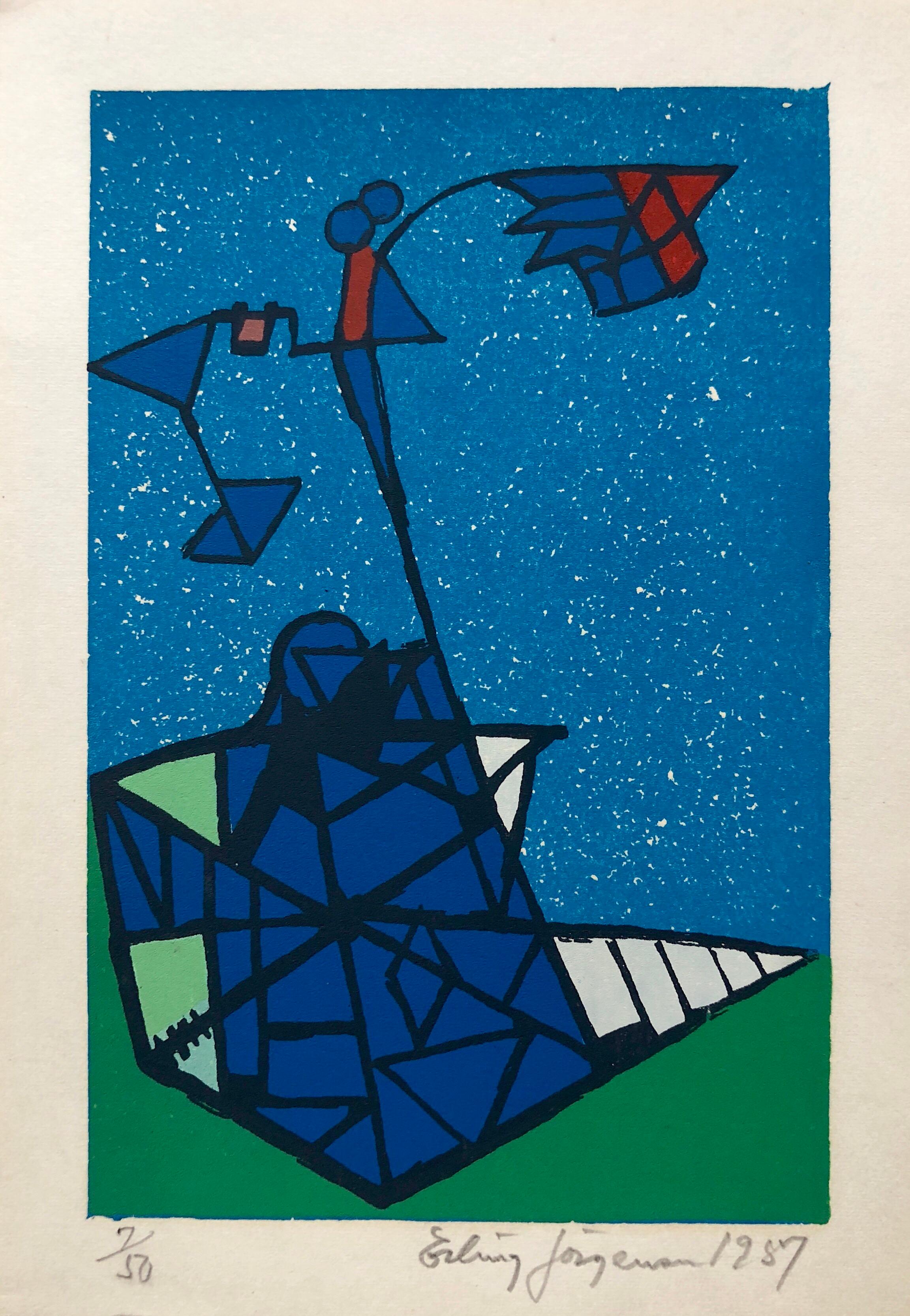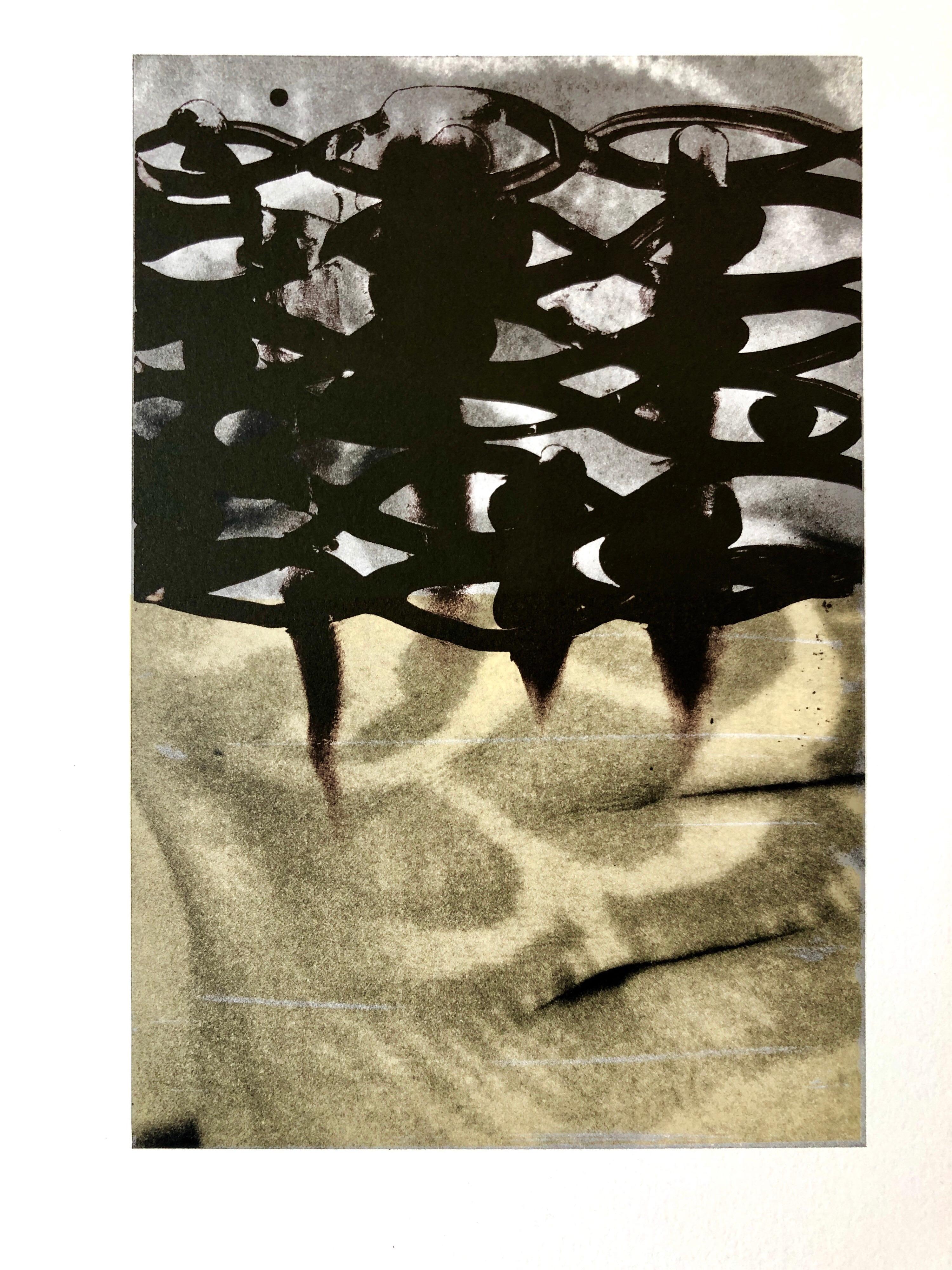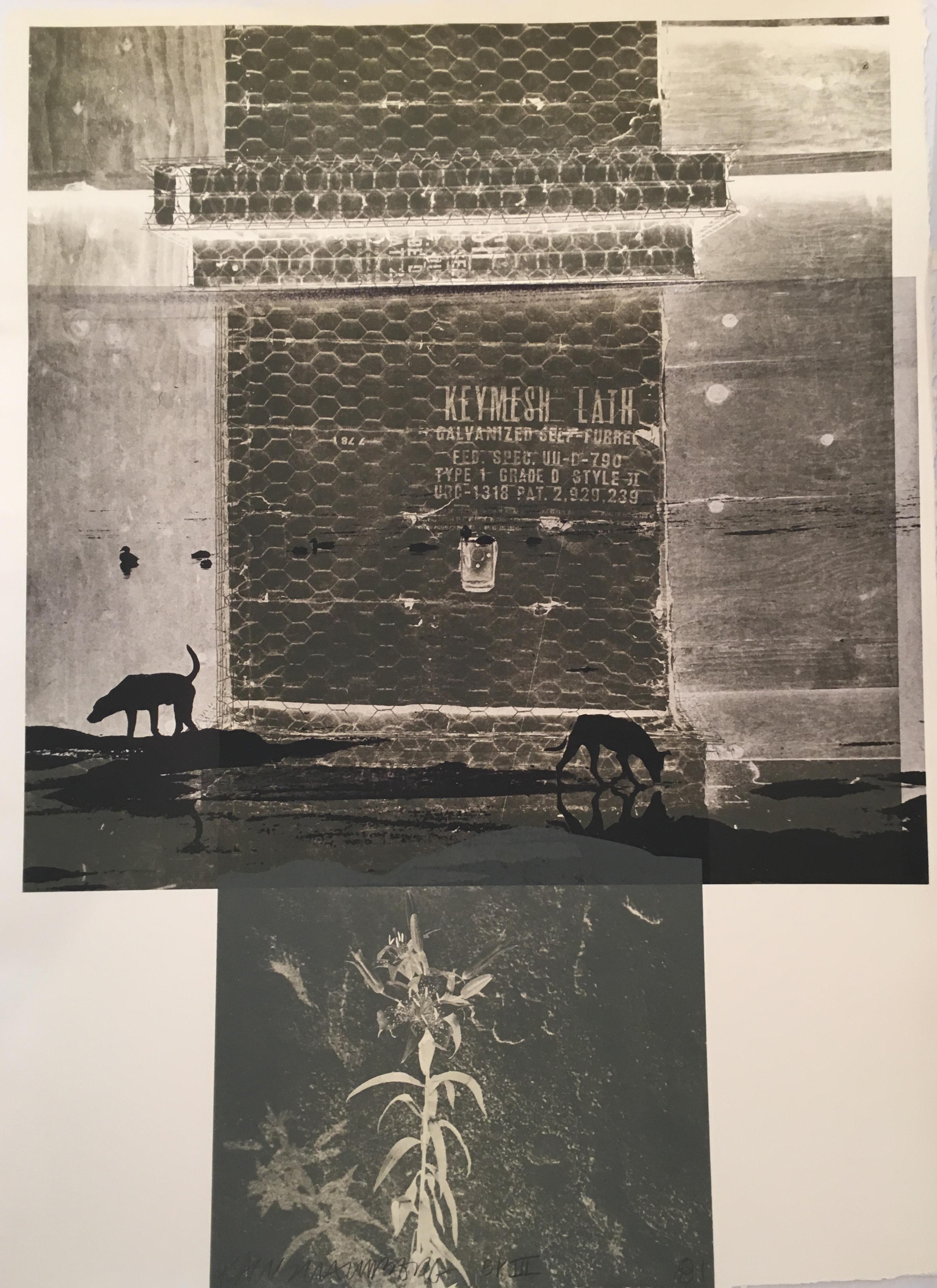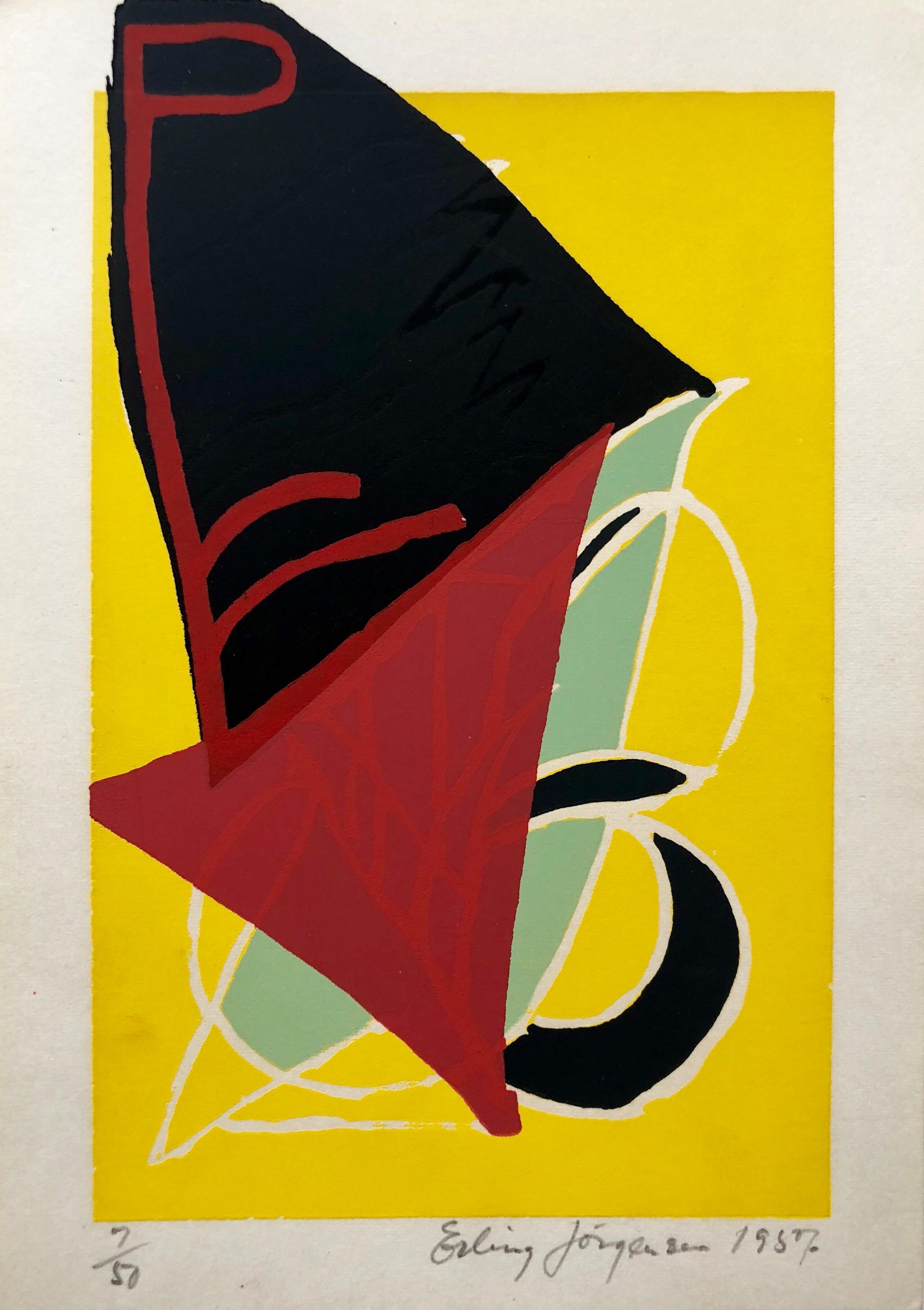Items Similar to "Two Bottles & Bowl, " Original Black & White Litho. signed by Joan Gardy Artigas
Want more images or videos?
Request additional images or videos from the seller
1 of 9
Joan Gardy Artigas"Two Bottles & Bowl, " Original Black & White Litho. signed by Joan Gardy ArtigasUnknown
Unknown
About the Item
"Two Bottles & Bowl" is an original lithograph by Joan Gardy Artigas. It depicts a still life in black and white. The artist signed the piece lower right and wrote the edition number (14/15).
19 3/4" x 25 3/4"
Joan Gardy Artigas (born 1938) is a Catalan ceramist, artist and (was) a close collaborator with Joan Miró.
Artigas was born on 18 June 1938 in Boulogne-Billancourt (near Paris) and his father was Josep Llorens Artigas who worked closely with Miró and Pablo Picasso. Artigas was able to work for Miró, whilst still a teenager, because of his father's relationship with Miró. Artigas trained at the Ecole des Beaux Arts in Paris where he met the Swiss sculptor Alberto Giacometti. Artigas established his own studio where at Giacometti's suggestion he concentrated on sculpture. Artigas had some success and supplied his expertise to the cubists Georges Braque and Marc Chagall.
When Artigas created the 7,200 tiles for the Miró Wall he coloured the tiles based on an image which Miró had created. Using that scale model, he marked out each section on an individual 20 by 36 centimetres (7.9 in × 14.2 in) tile. The artwork includes the signatures of both artists. Artigas' signature is dated 1979.
Artigas was later called to return to assisting Miró when his father decided to retire. His father had worked with Miró for twenty years creating large murals including examples for UNESCO, IBM and the Palacio de Exposiciones y Congresos in Madrid.Artigas worked with Miró on, Dona i Ocell, one of his last large works which was covered in broken tiles by Artigas. In this case the tiles remind the viewer of Gaudi's work.
In 1982 Antoni Tàpies won the Gold Medal of Catalonia for a mosaic in the Plaça de Catalunya in Sant Boi de Llobregat. Artigas had constructed the ceramics for this prize winning exhibit. Artigas continued his own art and he was awarded his first solo exhibition in America in 1982. He has been a visiting artist at two American universities and he has founded a foundation to celebrate his father's work. Gardy-Artigas serves on the board of the foundation Fundació Joan Miró in Barcelona.
- Creator:Joan Gardy Artigas (1949, French)
- Creation Year:Unknown
- Dimensions:Height: 19.75 in (50.17 cm)Width: 25.75 in (65.41 cm)
- Medium:
- Movement & Style:
- Period:
- Condition:
- Gallery Location:Milwaukee, WI
- Reference Number:
About the Seller
4.9
Platinum Seller
These expertly vetted sellers are 1stDibs' most experienced sellers and are rated highest by our customers.
Established in 1966
1stDibs seller since 2017
388 sales on 1stDibs
Typical response time: 1 hour
- ShippingRetrieving quote...Ships From: Milwaukee, WI
- Return PolicyA return for this item may be initiated within 14 days of delivery.
More From This SellerView All
- "Boldest Native" original lithograph signed pop art abstract hyperrealistic boldBy Michael KniginLocated in Milwaukee, WI"Boldest Native" is an original color lithograph by Michael Knigin. This piece features a pile of apples with abstract textures. The artist signed the piece lower right and titled it...Category
1980s Pop Art Still-life Prints
MaterialsLithograph
- "Back Cover of "Chagall Lithographe III, " M 577, " an Original Color LithographBy Marc ChagallLocated in Milwaukee, WIThis is the back cover of "Chagall Lithographe III," M 577". It is an original Lithograph by Marc Chagall. This print is a glorious black and red bouquet, most of the foliage is shown by black leaves and stems where as the flowers and blooms are red. Also on the top right one can see a tiny red bird. Image: 12.5 x 10 in Frame: 25.5 x 21.5 in Marc Chagall was born in Liozno, near Vitebsk, now in Belarus. The eldest of nine children in a close-knit Jewish family. His father Khatskl (Zakhar) Shagal, a herring merchant, and his mother, Feige-Ite. This period of his life, described as happy though impoverished, appears in references throughout Chagall's work. The family home on Pokrovskaya Street is now the Marc Chagall Museum. He began studying painting in 1906 with a local artist, Yehuda Pen. In 1907, he moved to St. Petersburg. There he joined the school of the Society of Art Supporters and studied under Nikolai Roerich. It was here that he was exposed to experimental theater and the work of such artists as Gauguin. From 1908-1910 Chagall studied under Leon Bakst at the Zvantseva School of Drawing and Painting. This was a difficult period for Chagall; at the time, Jewish residents were only allowed to live in St. Petersburg with a permit, and the artist was jailed for a brief period for an infringement of this restriction. Despite this, Chagall remained in St. Petersburg until 1910, and regularly visited his home town where, in 1909, he met his future wife, Bella Rosenfeld. After gaining a reputation as an artist, Chagall left St. Petersburg to settle in Paris to be near the burgeoning art community in the Montparnasse district, where he developed friendships with such avant-garde luminaries as Guillaume Apollinaire, Robert Delaunay, and Fernand Léger. In 1914, he returned to Vitebsk and, a year later, married his fiancée, Bella. While in Russia, World War I erupted and, in 1916, the Chagalls had their first child, a daughter named Ida. Chagall became an active participant in the Russian Revolution of 1917. Although the Soviet Ministry of Culture made him a Commissar of Art for the Vitebsk region, where he founded Vitebsk Museum of Modern Art and an art school, he did not fare well politically under the Soviet system. "Chagall was considered a non-person by the Soviets because he was Jewish and a painter whose work did not celebrate the heroics of the Soviet people."[6] He and his wife moved back to Paris in 1922. During this period, Chagall wrote articles, poetry and his memoirs (in Yiddish,) which were published mainly in newspapers (and only posthumously in book-form). Chagall became a French citizen in 1937. With the Nazi occupation of France during World War II and the deportation of Jews, the Chagalls fled Paris, seeking asylum at Villa Air-Bel in Marseille, where the American journalist Varian Fry assisted in their escape from France through Spain and Portugal. In 1941, the Chagalls settled in the United States where he lived until 1948 (his wife Bella died in 1944.) His wife Bella, who appears in many of his paintings, bore him one child, Ida and then died on September 2, 1944. Bella and Ida appeared in many of his early and most famous paintings. In 1945, he began a relationship with his housekeeper Virginia Haggard McNeil, with whom he had a son, David. In the 1950s, they moved to a villa in Provence. Virginia left him in 1952, and Chagall married Valentina Brodsky (whom he called "Vava"). Jewish influence: Chagall had a complex relationship with Judaism. On the one hand, he credited his Russian Jewish cultural background as being crucial to his artistic imagination. But however ambivalent he was about his religion, he could not avoid drawing upon his Jewish past for artistic material. As an adult, he was not a practicing Jew, but through his paintings and stained glass, he continually tried to suggest a more "universal message," using both Jewish and Christian themes...Category
1960s Surrealist Still-life Prints
MaterialsLithograph
- "Campions, " Lithograph Still Life by Sheila StaffordBy Sheila StaffordLocated in Milwaukee, WI"Campions" is an original color lithograph by Sheila Stafford. The artist signed the piece in the lower right and titled it and wrote the edition number (24/24) in the lower left - b...Category
1980s Still-life Prints
MaterialsLithograph
- "Bodegon - Still Life: Apple, Pear, & Funnel in Box, " Original Color LithographBy Armando MoralesLocated in Milwaukee, WI"Bodegon - Still Life: Apple, Pear & Funnel in Box" is an original color lithograph by Armando Morales. The artist signed the piece and this piece is the presentation proof for the e...Category
1980s Contemporary Still-life Prints
MaterialsLithograph
- "La Peine Perdue (The Wasted Effort)" Lithograph after Painting by Rene MagritteBy René MagritteLocated in Milwaukee, WI"La Peine Perdue (The Wasted Effort)" is a color lithograph after original 1962 painting by Rene Magritte. Two blue curtains are parted on either side. Two curtain shaped mirrors show a sky and clouds. A ball sits right to the left of the mirrors. Art: 12 x 9.75 in Frame: 22.75 x 20.38 in René-François-Ghislain Magritte was born November 21, 1898, in Lessines, Belgium and died on August 15, 1967 in Brussels. He is one of the most important surrealist artists. Through his art, Magritte creates humor and mystery with juxtapositions and shocking irregularities. Some of his hallmark motifs include the bourgeois “little man,” bowler hats, apples, hidden faces, and contradictory texts. René Magritte’s father was a tailor and his mother was a miller. Tragedy struck Magritte’s life when his mother committed suicide when he was only fourteen. Magritte and his two brothers were thereafter raised by their grandmother. Magritte studied at the Brussels Academy of Fine Arts from 1916 to 1918. After graduating he worked as a wallpaper designer and in advertisement. It was during this period that he married Georgette Berger, whom he had known since they were teenagers. In 1926, René Magritte signed...Category
2010s Surrealist Still-life Prints
MaterialsLithograph
- 'The Flower Vase' original hand-colored lithograph by Nathaniel CurrierBy Nathaniel CurrierLocated in Milwaukee, WIThe present hand-colored lithograph is one of several decorative images of flower-filled vases published by Nathaniel Currier. This example contains roses, tulips, forget-me-nots, and others all within a vase with gold eagle head handles and an image of a beautiful young woman the belly. 16 x 11 inches, artwork 22.5 x 18.25 inches, frame Entitled bottom center Signed in the stone, lower left "Lith. and Pub. by N. Currier" Inscribed lower right "152 Nassau St. Cor. of Spruce N.Y." Copyrighted bottom center "Entered according to Act of Congress in the year 1848 by N. Currier in the Clerk's office of the Southern District of N.Y." with the number 249 Framed to conservation standards using 100 percent rag matting, housed in a lemon gold moulding. Nathaniel Currier was a tall introspective man with a melancholy nature. He could captivate people with his piercing stare or charm them with his sparkling blue eyes. Nathaniel was born in Roxbury, Massachusetts on March 27th, 1813, the second of four children. His parents, Nathaniel and Hannah Currier, were distant cousins who lived a humble yet spartan life. When Nathaniel was eight years old, tragedy struck. Nathaniel’s father unexpectedly passed away leaving Nathaniel and his eleven-year-old brother Lorenzo to provide for the family. In addition to their mother, Nathaniel and Lorenzo had to care for six-year-old sister Elizabeth and two-year-old brother Charles. Nathaniel worked a series of odd jobs to support the family, and at fifteen, he started what would become a life-long career when he apprenticed in the Boston lithography shop of William and John Pendleton. A Bavarian gentleman named Alois Senefelder invented lithography just 30 years prior to young Nat Currier’s apprenticeship. While under the employ of the brothers Pendleton, Nat was taught the art of lithography by the firm’s chief printer, a French national named Dubois, who brought the lithography trade to America. Lithography involves grinding a piece of limestone flat and smooth then drawing in mirror image on the stone with a special grease pencil. After the image is completed, the stone is etched with a solution of aqua fortis leaving the greased areas in slight relief. Water is then used to wet the stone and greased-ink is rolled onto the raised areas. Since grease and water do not mix, the greased-ink is repelled by the moisture on the stone and clings to the original grease pencil lines. The stone is then placed in a press and used as a printing block to impart black on white images to paper. In 1833, now twenty-years old and an accomplished lithographer, Nat Currier left Boston and moved to Philadelphia to do contract work for M.E.D. Brown, a noted engraver and printer. With the promise of good money, Currier hired on to help Brown prepare lithographic stones of scientific images for the American Journal of Sciences and Arts. When Nat completed the contract work in 1834, he traveled to New York City to work once again for his mentor John Pendleton, who was now operating his own shop located at 137 Broadway. Soon after the reunion, Pendleton expressed an interest in returning to Boston and offered to sell his print shop to Currier. Young Nat did not have the financial resources to buy the shop, but being the resourceful type he found another local printer by the name of Stodart. Together they bought Pendleton’s business. The firm ‘Currier & Stodart’ specialized in "job" printing. They produced many different types of printed items, most notably music manuscripts for local publishers. By 1835, Stodart was frustrated that the business was not making enough money and he ended the partnership, taking his investment with him. With little more than some lithographic stones, and a talent for his trade, twenty-two year old Nat Currier set up shop in a temporary office at 1 Wall Street in New York City. He named his new enterprise ‘N. Currier, Lithographer’ Nathaniel continued as a job printer and duplicated everything from music sheets to architectural plans. He experimented with portraits, disaster scenes and memorial prints, and any thing that he could sell to the public from tables in front of his shop. During 1835 he produced a disaster print Ruins of the Planter's Hotel, New Orleans, which fell at two O’clock on the Morning of the 15th of May 1835, burying 50 persons, 40 of whom Escaped with their Lives. The public had a thirst for newsworthy events, and newspapers of the day did not include pictures. By producing this print, Nat gave the public a new way to “see” the news. The print sold reasonably well, an important fact that was not lost on Currier. Nat met and married Eliza Farnsworth in 1840. He also produced a print that same year titled Awful Conflagration of the Steamboat Lexington in Long Island Sound on Monday Evening, January 18, 1840, by which melancholy occurrence over One Hundred Persons Perished. This print sold out very quickly, and Currier was approached by an enterprising publication who contracted him to print a single sheet addition of their paper, the New York Sun. This single page paper is presumed to be the first illustrated newspaper ever published. The success of the Lexington print launched his career nationally and put him in a position to finally lift his family up. In 1841, Nat and Eliza had their first child, a son they named Edward West Currier. That same year Nat hired his twenty-one year old brother Charles and taught him the lithography trade, he also hired his artistically inclined brother Lorenzo to travel out west and make sketches of the new frontier as material for future prints. Charles worked for the firm on and off over the years, and invented a new type of lithographic crayon which he patented and named the Crayola. Lorenzo continued selling sketches to Nat for the next few years. In 1843, Nat and Eliza had a daughter, Eliza West Currier, but tragedy struck in early 1847 when their young daughter died from a prolonged illness. Nat and Eliza were grief stricken, and Eliza, driven by despair, gave up on life and passed away just four months after her daughter’s death. The subject of Nat Currier’s artwork changed following the death of his wife and daughter, and he produced many memorial prints and sentimental prints during the late 1840s. The memorial prints generally depicted grief stricken families posed by gravestones (the stones were left blank so the purchasers could fill in the names of the dearly departed). The sentimental prints usually depicted idealized portraits of women and children, titled with popular Christian names of the day. Late in 1847, Nat Currier married Lura Ormsbee, a friend of the family. Lura was a self-sufficient woman, and she immediately set out to help Nat raise six-year-old Edward and get their house in order. In 1849, Lura delivered a son, Walter Black Currier, but fate dealt them a blow when young Walter died one year later. While Nat and Lura were grieving the loss of their new son, word came from San Francisco that Nat’s brother Lorenzo had also passed away from a brief illness. Nat sank deeper into his natural quiet melancholy. Friends stopped by to console the couple, and Lura began to set an extra place at their table for these unexpected guests. She continued this tradition throughout their lives. In 1852, Charles introduced a friend, James Merritt Ives, to Nat and suggested he hire him as a bookkeeper. Jim Ives was a native New Yorker born in 1824 and raised on the grounds of Bellevue Hospital where his father was employed as superintendent. Jim was a self-trained artist and professional bookkeeper. He was also a plump and jovial man, presenting the exact opposite image of his new boss. Jim Ives met Charles Currier through Caroline Clark, the object of Jim’s affection. Caroline’s sister Elizabeth was married to Charles, and Caroline was a close friend of the Currier family. Jim eventually proposed marriage to Caroline and solicited an introduction to Nat Currier, through Charles, in hopes of securing a more stable income to support his future wife. Ives quickly set out to improve and modernize his new employer’s bookkeeping methods. He reorganized the firm’s sizable inventory, and used his artistic skills to streamline the firm’s production methods. By 1857, Nathaniel had become so dependent on Jims’ skills and initiative that he offered him a full partnership in the firm and appointed him general manager. The two men chose the name ‘Currier & Ives’ for the new partnership, and became close friends. Currier & Ives produced their prints in a building at 33 Spruce Street where they occupied the third, fourth and fifth floors. The third floor was devoted to the hand operated printing presses that were built by Nat's cousin, Cyrus Currier, at his shop Cyrus Currier & Sons in Newark, NJ. The fourth floor found the artists, lithographers and the stone grinders at work. The fifth floor housed the coloring department, and was one of the earliest production lines in the country. The colorists were generally immigrant girls, mostly German, who came to America with some formal artistic training. Each colorist was responsible for adding a single color to a print. As a colorist finished applying their color, the print was passed down the line to the next colorist to add their color. The colorists worked from a master print displayed above their table, which showed where the proper colors were to be placed. At the end of the table was a touch up artist who checked the prints for quality, touching-in areas that may have been missed as it passed down the line. During the Civil War, demand for prints became so great that coloring stencils were developed to speed up production. Although most Currier & Ives prints were colored in house, some were sent out to contract artists. The rate Currier & Ives paid these artists for coloring work was one dollar per one hundred small folios (a penny a print) and one dollar per one dozen large folios. Currier & Ives also offered uncolored prints to dealers, with instructions (included on the price list) on how to 'prepare the prints for coloring.' In addition, schools could order uncolored prints from the firm’s catalogue to use in their painting classes. Nathaniel Currier and James Merritt Ives attracted a wide circle of friends during their years in business. Some of their more famous acquaintances included Horace Greeley, Phineas T. Barnum, and the outspoken abolitionists Rev. Henry Ward, and John Greenleaf Whittier (the latter being a cousin of Mr. Currier). Nat Currier and Jim Ives described their business as "Publishers of Cheap and Popular Pictures" and produced many categories of prints. These included Disaster Scenes, Sentimental Images, Sports, Humor, Hunting Scenes, Politics, Religion, City and Rural Scenes, Trains, Ships, Fire Fighters, Famous Race Horses, Historical Portraits, and just about any other topic that satisfied the general public's taste. In all, the firm produced in excess of 7500 different titles, totaling over one million prints produced from 1835 to 1907. Nat Currier retired in 1880, and signed over his share of the firm to his son Edward. Nat died eight years later at his summer home 'Lion’s Gate' in Amesbury, Massachusetts. Jim Ives remained active in the firm until his death in 1895, when his share of the firm passed to his eldest son, Chauncey. In 1902, faced will failing health from the ravages of Tuberculosis, Edward Currier sold his share of the firm to Chauncey Ives...Category
1840s Romantic Still-life Prints
MaterialsWatercolor, Lithograph
You May Also Like
- Cobra Artist 1950s Silkscreen Serigraph Bright Colorful Abstract Hand SignedBy Erling JorgensenLocated in Surfside, FLSmall vintage hand signed and dated graphic. limited edition. Erling Jørgensen, 1905-1977 Born in Denmark, self taught artist. painter and graphic. print-maker. Danish painter and gr...Category
1950s Abstract Expressionist Abstract Prints
MaterialsLithograph
- Cobra Artist 1950s Silkscreen Serigraph Bright Colorful Abstract Hand SignedBy Erling JorgensenLocated in Surfside, FLSmall vintage hand signed and dated graphic. limited edition. Erling Jørgensen, 1905-1977 Born in Denmark, self taught artist. painter and graphic. print-maker. Danish painter and gr...Category
1950s Abstract Expressionist Abstract Prints
MaterialsLithograph
- Set of Eyes, Color Lithograph, Belgian Abstract Expressionist Tamarind PrintBy Dirk de BruyckerLocated in Surfside, FLSigned, dated and titled. Initialed and dated lower right, each numbered 8/20, lower left. 9 x 6 image size, 22 x 15 in. sheet size. With the blindstamp of the Tamarind Institute print...Category
1990s Abstract Expressionist Abstract Prints
MaterialsArchival Paper, Lithograph
- Lily ScentBy Robert RauschenbergLocated in New York, NYRobert Rauschenberg Lily Scent, 1981 Lithograph 32 x 24 inches SPIII SignedCategory
1980s Abstract Expressionist Still-life Prints
MaterialsLithograph
- Cobra Artist 1950s Silkscreen Serigraph Bright Colorful Abstract Hand SignedBy Erling JorgensenLocated in Surfside, FLSmall vintage hand signed and dated graphic. limited edition. Erling Jørgensen, 1905-1977 Born in Denmark, self taught artist. painter and graphic. print-maker. Danish painter and gr...Category
1950s Abstract Expressionist Abstract Prints
MaterialsLithograph
- Seaweed (Algue)By Ellsworth KellyLocated in New York, NYFrom the Plant Lithographs suite 1964-66Category
1960s Abstract Expressionist Still-life Prints
MaterialsLithograph
Recently Viewed
View AllMore Ways To Browse
Alberto Giacometti Signed
Black Train Case
Retro White Tiles
Black And Gold Bowl
Vintage Studio Tile
Picasso Lithograph Still Life
White Sculpture Bowl
Pablo Picasso Gold Sculpture
White Cubist Sculpture
Large Black And White Bowl
Large Miro Lithograph
Vintage Black And White Tile
Abstract Still Life Braque
Abstract Still Life Bottles
Medalion Bowl
Pablo Picasso Foundation
Retro Black And White Tile
Vintage Art Supply Case





